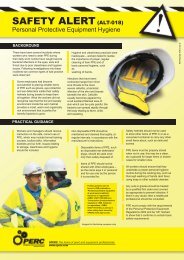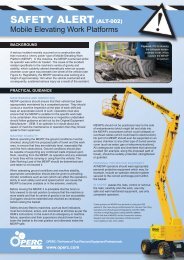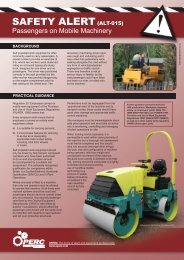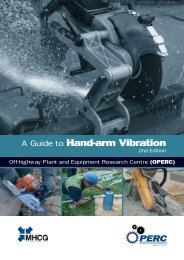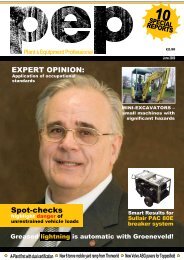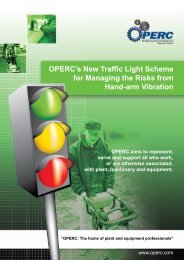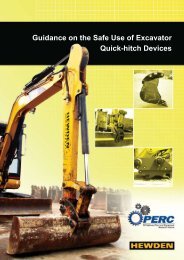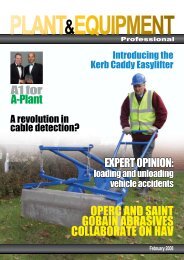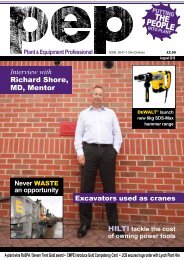ALERT
Download A3 poster (filesize approx 4MB) - OPERC
Download A3 poster (filesize approx 4MB) - OPERC
- No tags were found...
You also want an ePaper? Increase the reach of your titles
YUMPU automatically turns print PDFs into web optimized ePapers that Google loves.
SAFETY <strong>ALERT</strong> (ALT-003)<br />
All-Round Awareness for Plant Operators<br />
BACKGROUND<br />
Over recent years, numerous incidents have occurred where mobile plant has come into<br />
contact with pedestrians. In some instances the pedestrian has escaped with minor injury,<br />
while in others a major injury, or even fatality, has occurred.<br />
The causes of such incidents include:<br />
poor safety control measures on site;<br />
inadequate (or lack of) additional aids and devices to increase all-round awareness<br />
(such as mirrors, radar, sonar, or rear view cameras); and<br />
operator inexperience and / or fatigue.<br />
The risk of plant / pedestrian contact must be controlled and part of this control will<br />
embrace operator all-round awareness (ARA).<br />
PRACTICAL GUIDANCE<br />
Only trained and competent operators<br />
should operate plant. The nationally<br />
recognised qualification for competence in<br />
Britain is a Scottish / National Vocational<br />
Qualification (S/NVQ) Level II<br />
Plant Operations.<br />
When conducting a risk assessment for plant<br />
with a visibility blind spot (such as caused<br />
by a boom on a rough terrain telescopic<br />
handler), the extent of any such problem<br />
should be determined and appropriate<br />
remedies set in place. Plant operators<br />
must be able to see around their machines,<br />
regardless of size or configuration. The<br />
industry best practice standard for risk<br />
assessment is 1m x 1m.<br />
The plant item to be operated should be<br />
suitable for the work intended. Additional<br />
devices such as sonar, radar, convex mirrors<br />
or rear view cameras may be required to suit<br />
a particular work environment.<br />
Pencil beam (flat mirrors) that have<br />
been fitted to a plant item by the original<br />
equipment manufacturer (OEM) should<br />
not be removed. Any other ARA devices<br />
fitted (such as convex mirrors) should be<br />
in addition to – and not in place of – OEM<br />
visibility aids.<br />
Wherever possible, the need for reversing<br />
should be eliminated, or otherwise<br />
minimised. This may be achieved, for<br />
example, by changes in the design of the<br />
work process or by specifying an alternative<br />
item of plant (such as a side tipping, instead<br />
of forward tipping, site dump truck).<br />
Plant should be maintained so that it<br />
is working safely and efficiently and a<br />
machine inspection should be conducted<br />
by the operator at the start of each shift<br />
and an appropriate record maintained.<br />
Any maintenance or inspection should<br />
follow guidance as laid out by the<br />
OEM. Operators must check that any<br />
additional ARA devices are working<br />
correctly and are not damaged in any<br />
way. If any safety devices or visibility<br />
aids are found to be damaged or faulty,<br />
then the plant item must not be operated<br />
until the damage or fault has been<br />
corrected.<br />
Site personnel should be excluded<br />
from the ‘operational area’ of any plant<br />
item. This can be achieved by using<br />
designated vehicle transport routes and<br />
other plant / pedestrian segregation<br />
control measures such as physical<br />
barriers, traffic light systems, zebra<br />
crossings and signage.<br />
All personnel on site should wear<br />
appropriate personal protective<br />
equipment, including high visibility vests<br />
or jackets which incorporate reflective<br />
material.<br />
In summary: use competent workers,<br />
in safe plant, with adequate aids to<br />
enhance all-round awareness and<br />
segregate plant and pedestrians as far<br />
as is practically possible.<br />
Produced with the support of Spillard Safety Systems: www.spillard.com<br />
Under PUWER 1998, Regulation 17 concerns<br />
the control of work equipment. Regulation 17(3)<br />
(a) of the HSE booklet L22 states that: “So far<br />
as is reasonably practicable, the operator of any<br />
control is able [should be able] to ensure from<br />
the position of that control that no person is in a<br />
place where he would be exposed to any risk to<br />
his health and safety as a result of the operation<br />
of that control.”<br />
Regulation 28[e] considers the driver’s field<br />
of view. This Regulation applies when mobile<br />
work equipment is about to move, or when it is<br />
travelling: “Where a driver’s direct field of vision is<br />
inadequate to ensure safety, then visibility aids or<br />
other suitable devices should be provided so far<br />
as is reasonably practicable.”<br />
Additional guidance can be<br />
found in the OPERC publication<br />
‘A Practical Guide to Enhancing<br />
the All-Round Awareness of<br />
Plant Operators’, which is<br />
available through the OPERC<br />
on-line bookshop at:<br />
www.operc.com.<br />
OPERC: The Home of True Plant and Equipment Professionals<br />
www.operc.com
SAFETY <strong>ALERT</strong> (ALT-003)<br />
All-Round Awareness for Plant Operators<br />
BACKGROUND<br />
Over recent years, numerous incidents have occurred where mobile plant has come into<br />
contact with pedestrians. In some instances the pedestrian has escaped with minor injury,<br />
while in others a major injury, or even fatality, has occurred.<br />
The causes of such incidents include:<br />
poor safety control measures on site;<br />
inadequate (or lack of) additional aids and devices to increase all-round awareness<br />
(such as mirrors, radar, sonar, or rear view cameras); and<br />
operator inexperience and / or fatigue.<br />
The risk of plant / pedestrian contact must be controlled and part of this control will<br />
embrace operator all-round awareness (ARA).<br />
PRACTICAL GUIDANCE<br />
Only trained and competent operators<br />
should operate plant. The nationally<br />
recognised qualification for competence in<br />
Britain is a Scottish / National Vocational<br />
Qualification (S/NVQ) Level II<br />
Plant Operations.<br />
When conducting a risk assessment for plant<br />
with a visibility blind spot (such as caused<br />
by a boom on a rough terrain telescopic<br />
handler), the extent of any such problem<br />
should be determined and appropriate<br />
remedies set in place. Plant operators<br />
must be able to see around their machines,<br />
regardless of size or configuration. The<br />
industry best practice standard for risk<br />
assessment is 1m x 1m.<br />
The plant item to be operated should be<br />
suitable for the work intended. Additional<br />
devices such as sonar, radar, convex mirrors<br />
or rear view cameras may be required to suit<br />
a particular work environment.<br />
Pencil beam (flat mirrors) that have<br />
been fitted to a plant item by the original<br />
equipment manufacturer (OEM) should<br />
not be removed. Any other ARA devices<br />
fitted (such as convex mirrors) should be<br />
in addition to – and not in place of – OEM<br />
visibility aids.<br />
Wherever possible, the need for reversing<br />
should be eliminated, or otherwise<br />
minimised. This may be achieved, for<br />
example, by changes in the design of the<br />
work process or by specifying an alternative<br />
item of plant (such as a side tipping, instead<br />
of forward tipping, site dump truck).<br />
Plant should be maintained so that it<br />
is working safely and efficiently and a<br />
machine inspection should be conducted<br />
by the operator at the start of each shift<br />
and an appropriate record maintained.<br />
Any maintenance or inspection should<br />
follow guidance as laid out by the<br />
OEM. Operators must check that any<br />
additional ARA devices are working<br />
correctly and are not damaged in any<br />
way. If any safety devices or visibility<br />
aids are found to be damaged or faulty,<br />
then the plant item must not be operated<br />
until the damage or fault has been<br />
corrected.<br />
Site personnel should be excluded<br />
from the ‘operational area’ of any plant<br />
item. This can be achieved by using<br />
designated vehicle transport routes and<br />
other plant / pedestrian segregation<br />
control measures such as physical<br />
barriers, traffic light systems, zebra<br />
crossings and signage.<br />
All personnel on site should wear<br />
appropriate personal protective<br />
equipment, including high visibility vests<br />
or jackets which incorporate reflective<br />
material.<br />
In summary: use competent workers,<br />
in safe plant, with adequate aids to<br />
enhance all-round awareness and<br />
segregate plant and pedestrians as far<br />
as is practically possible.<br />
Produced with the support of Spillard Safety Systems: www.spillard.com<br />
Under PUWER 1998, Regulation 17 concerns<br />
the control of work equipment. Regulation 17(3)<br />
(a) of the HSE booklet L22 states that: “So far<br />
as is reasonably practicable, the operator of any<br />
control is able [should be able] to ensure from<br />
the position of that control that no person is in a<br />
place where he would be exposed to any risk to<br />
his health and safety as a result of the operation<br />
of that control.”<br />
Regulation 28[e] considers the driver’s field<br />
of view. This Regulation applies when mobile<br />
work equipment is about to move, or when it is<br />
travelling: “Where a driver’s direct field of vision is<br />
inadequate to ensure safety, then visibility aids or<br />
other suitable devices should be provided so far<br />
as is reasonably practicable.”<br />
Additional guidance can be<br />
found in the OPERC publication<br />
‘A Practical Guide to Enhancing<br />
the All-Round Awareness of<br />
Plant Operators’, which is<br />
available through the OPERC<br />
on-line bookshop at:<br />
www.operc.com.<br />
OPERC: The Home of True Plant and Equipment Professionals<br />
www.operc.com



